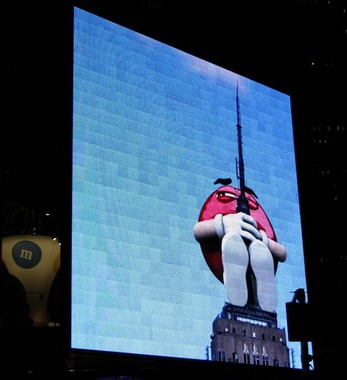The 24-Hour Commercial: Signs of Our Times

Our ancestors drew on cave walls. We draw on buildings.
There is, for instance, a two-story retail outlet in New York's Times Square devoted to all things M&M. (Not bad for a chocolate that is about the size of a shirt button.)
On one corner is a 50-foot-wide by 60-foot-deep digital sign, touting the candy's irresistible qualities. On the other corner, it's a square sign 32 feet deep and 32 feet wide.
All told, there's about 4.3 trillion color combinations possible in the big one. The light-emitting diodes that produce them last seven to 10 years each.
This makes possible the 24-hour commercial, at $1.5 million or so a whack to create such a sign. Beats the cost of a 30-second Super Bowl spot. Even though "only" about 1.5 million people walk through Times Square each week.
But Times Square is not the only locale now becoming the backdrop for these megasigns, which are giving rise to construction specialties known as "advertecture" and "mediatecture." There's a museum in Milan with one so-called media facade. In Dubai -- where else -- a digital sign that is 33 stories tall is in the works. It can be viewed two miles away. Beijing has a "sky screen." And soon, there will be a proof of concept that there can a massive sign with "zero energy impact,'' solely powered by solar power.
Is this modern equivalent of the cave drawing a good thing?
Yes, argues consultant Richard Willard of Rule7Media. Print media are becoming "irrelevant.'' And someone -- some thing -- has to provide an alternative. "We need mass communications," he said this week at the Renaissance Hotel in Times Square, overlooking the M&M signs. "We need cultural glue,'' he said.
The glue is going to get pretty interesting, pretty fast, if you love all things digital. Sign consultant Barry Winston, who handles most of the projects in Times Square, characterizes what these signs now constitute as 21st century mimes. But that will not last.
High-definition-like resolution has already come to the big signs, with picture elements in the M&M sign just 12 millimeters apart. Movement is a given. The next wave: Coupons, audio and interactivity.
Coupons have already, in effect, appeared on the M&M signs. Want to get $1 off a product inside the store? Just wait until a code shows up on the sign. Then, take a photo of it on your cell phone and walk into the store to claim it, says Jason Barak, managing partner of sales and marketing for Dynamic Digital Displays of North Bergen, N.J.
Audio? Wait for the phone number to show up on screen, then dial it. You can listen to the pitch for whatever product or service is on the screen.
Interactivity? Last New Year's Eve, it already arrived in Times Square. Festivity goers could take photos of themselves, send them to a designated number and see them up on the big screen shortly thereafter.
On the way: a word game that theatre-goers can play while waiting to purchase half-price ducats at the TKTS stand in Times Square. In the digital sign equivalent of the word game Jumble, players can send in as many combinations that spell out words as they can figure out from a given set of letters. And see their names light up as winners, while in line, at a digital sign across the street where the contest is being displayed and played at the same time.
All of this demonstrates just how far we've come from the days when rocks were painted with meanings that we're still trying to decipher thousands of years later.
But if it comes to pass that a piece no building is worth the foundation its built on unless it is a piece of 'advertecture' and The New York Times building winds up being the canvas for the creation of an incarnation of 'mediatecture' that delivers the news to the masses on its exterior more effectively than on paper or a personal computer screen, a few folks might just try to find a cave to crawl into.
More: Click over to CNET TV to view "Bright Lights, Big City" which describes the equipment that powers and controls digital signage in Times Square. Randall Bennett's report comes after the news highlights. Image sources: flatmichael.blogspot.com, ZDNet
